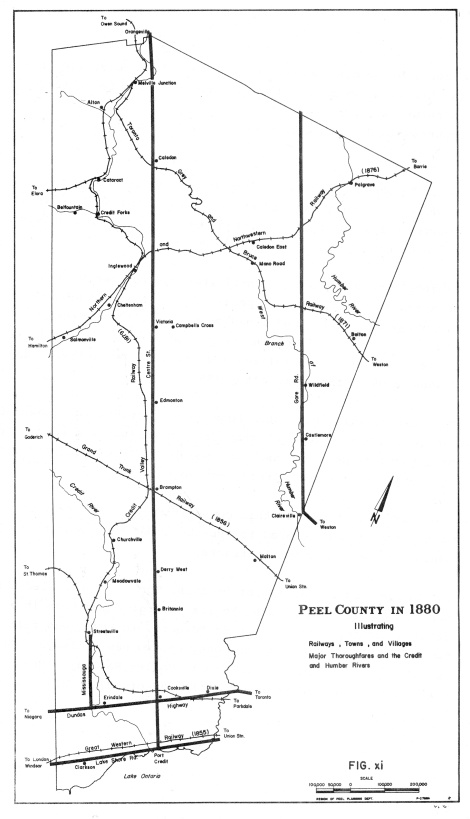Prior to the mid-1850s travelling in Peel involved relying on the small but growing road network or using the major waterways such as the Credit and Humber Rivers and Lake Ontario. However, this began to change in 1855 with the opening of the first railway line to cross Peel, the Great Western Railway (now Canadian National railways)
The various railway lines that eventually criss-crossed Peel were a major factor in the development of the area from the mid-1850s onwards; the arrival of a railway station in a community meant that it would benefit from increased traffic, commerce, development, and connections to locations both within and beyond Peel. Those settlements that were connected to the railway grew and prospered while others declined and often vanished.

This map, commissioned in the early 1930s by Peel historian Wm. Perkins Bull, documents early settlements in the Peel area, including Streestville, Brampton, and Caledon East, as well as lesser known settlements such as Pucky Huddle, Alloa, and Lockton.
Given their significant role in the community, it is of little wonder that the records created by the railways are of interest to archivists and historians. So, we are very pleased to announce that due to a number of donations and government transfers last year, we now have substantial records documenting activity at Streetsville, Brampton and Caledon East railways stations. Previously the bulk of our official railway records were from the Brampton area, but now our patrons can also consult records created and used by railway officials in Mississauga and Caledon.

Rail station and line locations in Peel as of 1880: Rail lines crossing Peel have been operated by a number of different companies over the years, including Great Western, Grand Trunk, Credit Valley, Northern and Northwestern, and more recently, Canadian National and Canadian Pacific. Map source: “Settlement History of Peel,” 1975
An overview of the official railway records in our holdings follows. (For more information on the language we use to describe records please check our post on archival description.)
Streetsville CPR railway station fonds, 1905-1970
Fonds consists of records created and/or collected by railway company staff working at the Streetsville railway station, and includes remittance and cash books, code of safety rules and safe practices, and various company forms.
Brampton CPR railway station fonds, 1910-[ca.1967]
Fonds consists of records created and/or collected by staff working at the Brampton CPR railway station. Records include waybills, telegrams, correspondence, memos/circulars, tariff policy documents, receipts, cash and ticket books, blank forms, newspaper clippings, and other material. Many of the records were created or collected by Station Master E. A. Hay.
Caledon East railway station fonds, 1898-1971, predominant 1898-1916
Fonds consists of records created and/or collected by railway company staff working at the Caledon East railway station. The majority of the fonds is comprised of waybills, with other material including memos, telegrams, shipping contracts, tariff policy documents, railway signs with notices to passengers, and a small amount of ephemera (including cancelled tickets and ticket stubs).
These official railway records are complemented by other resources in our holdings, including, but not limited to:
- The transportation and communication research files of Peel historian Wm. Perkins Bull (compiled in the 1930s)
- 1870s and 1880s railway photographs found in the Paul Caulfield fonds
- Various railway station and locomotive photographs found in the Region of Peel Archives photograph collection and the Richard Frost postcard collection
Railway workers, Credit Forks, Township of Caledon, [ca. 1890]
Patrons wishing to view any of the above records are asked to book an appointment: PAMAarchives@peelregion.ca. Thank you!
Kyle Neill, Senior Archivist










![Canadian Pacific Railway station, Brampton, [ca. 1910] PN2009_91207](https://peelarchivesblog.files.wordpress.com/2018/03/canadian-pacific-railway-station-brampton-ca-1910-pn2009_91207.jpg?w=470)
![Grand Trunk Railway station, Caledon East, [ca. 1905] PN2009_91147](https://peelarchivesblog.files.wordpress.com/2018/03/grand-trunk-railway-station-caledon-east-ca-1905-pn2009_91147.jpg?w=470)
![Railway workers, Credit Forks, Township of Caledon, [ca. 1890]](https://peelarchivesblog.files.wordpress.com/2018/03/railway-workers-credit-forks-township-of-caledon-ca-1890.jpg?w=636&h=474)
Pingback: Canadian History Roundup – Week of March 11, 2018 | Unwritten Histories·